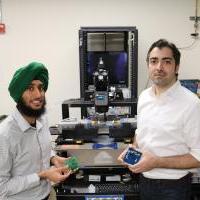
"As smartphone users know all too well, a sleeping device can still suck the life out of a battery. One solution for extending the battery life of wireless devices under development by researchers at Stanford University is to add a wake-up receiver that can turn on a shut-off device at a moment’s notice.
Angad Rekhi, a graduate student in the Arbabian lab at Stanford, and Amin Arbabian, assistant professor of electrical engineering, have developed a wake-up receiver that turns on a device in response to incoming ultrasonic signals – signals outside the range that humans can hear. By working at a significantly smaller wavelength and switching from radio waves to ultrasound, this receiver is much smaller than similar wake-up receivers that respond to radio signals, while operating at extremely low power and with extended range. The group is presenting the work at the International Solid-State Circuits Conference on Feb. 14.
This wake-up receiver has many potential applications, particularly in designing the next generation of networked devices, including so-called 'smart' devices that can communicate directly with one another without human intervention.
'As technology advances, people use it for applications that you could never have thought of. The internet and the cellphone are two great examples of that,' said Rekhi. 'I’m excited to see how people will use wake-up receivers to enable the next generation of the Internet of Things.'"
Excerpt from the Stanford Report "Stanford researchers develop new method for waking up small electronic devices"


